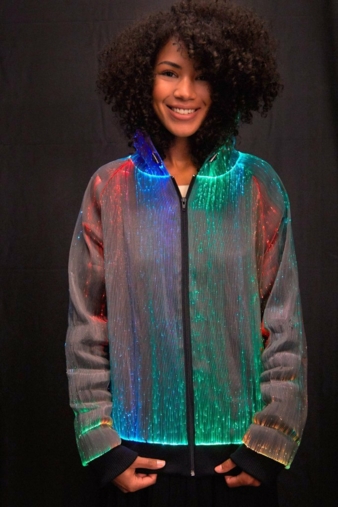05/08/2019 – Smart Textiles — auf Deutsch lesen
Visible boost for e-textiles
After the long years of development work, international analysts and market commentators are anticipating a trade in smart textiles worth billions.
textile network took a look around at this year’s Techtextil and what we found was smart textiles as far as the eye could see. Clever textiles – after overcoming numerous problems of infancy such as poor washability or kink resistance, and having passed through the stage of manual prototypes – are now at least on the starting line of (partially automated) mass production for volume market launch. User applications await in fields such as fashion, workwear, medical technology, construction and architecture, as well as the whole mobility sector and digital industry, providing interfaces between humans and machines. All of these target areas are expecting, and expected, to trigger an explosion of innovation in products and processes with smart textile technology.
Lunative Laboratories
Smart textile innovation is the prime example of applications offered by the new ‘Luna Smart IoT’ technology from Lunative Laboratories. The company, a technological pioneer in textile conductivity, uses light components (ten ‘smart ambience’ sensors feeding 50 light fibres) incorporated in the fabric. These can be controlled either actively via a user interface or mobile device or – as here – passively through music, for example. The sound becomes emotionally visible: where this would once have been achieved through a disco ball, it now comes through fibres and follows the beat of the music.
Markets expect an increase of e-textiles
Jacquard by Google, after all, expects that by 2025, one in ten people will be connecting their clothing to the internet in one way or another. The Centre for European Economic Research, on behalf of the German Federal Ministry of Economics, has forecast a nearly fourfold global increase in market volume for smart textiles between 2017 (EUR 1.3 bn) and 2022 (almost EUR 5.0 bn). In Germany specifically, where the foundations for a diverse range of directions in electro-textiles were laid down nearly 20 years ago at the Thüringen-Vogtland Textile Research Institute (TITV), this forecast includes potential growth in e-textile sales of EUR 4.2 bn over 11 years.
Energy transmission and storage
Textiles with an intelligent dimension are electrically driven and therefore need access to power from batteries, energy harvesting, self-generated electricity or a wireless power supply. Against this background, Techtextil stood ready with a whole package of new options.
Highly charged examples
The German Institutes of Textile and Fibre Research have added a new chapter to contactless charging with an embroidered charging coil – and have won an innovation award for it. Fraunhofer ENAS in Paderborn is also working on textile coils for energy transfer, although their route is based on woven technology.
Turkish manufacturer Ariteks Boyacilik Ticaret ve Sanayi AS presented the latest generation of solar cells. Based on glass fibres, these can be laminated into any kind of textile structure and allow the user to charge a mobile phone simply by plugging it into a USB port in the clothing.
LiTex –a continuous roll of RFID tags
Mass production of RFID tags – in this case on a continuous roll – was demonstrated by the Taiwanese manufacturer LiTex. The integral woven-in conductive wires also serve as antennae. With its specially coated RFID tags, the Fraunhofer Technical Textiles Alliance is targeting the issue of textile cleaning (maximising the number of wash cycles while continuing to meet stringent demands).
Steel-tech, the smart yarn
In the context of high wash frequency, particularly for workwear in the medical and care sectors, yarn manufacturer Amann has launched Steel-tech, a smart yarn. This is incorporated into a base material from which washable and robust RFID wireless labels can be made. The transponder in the fabric counts the washing cycles.
RFID in satin clothing
Kuny AG from Switzerland is weaving similar antennae with a range of at least ten metres into attractively coloured satin ribbons. Such textile antennae, in conjunction with a RAIN RFID and NFC chip module, allow textiles to be integrated into the ‘internet of things’ (IoT). This would be of benefit, for example, to product manufacturers, logistics companies and retail chains, offering full transparency of the supply chain and stock situation in real time. At the same time, Kuny’s solution also offers invisible data protection and the opportunity to communicate with customers.
Getting light into the component
Another area of difficulty in mass production – combining elastic textile conductive strips with electronic components – has been solved by Amohr, in collaboration with textile researchers at Denkendorf. At the heart of the Fast-E-Tex project is a partially elastic conductive tape with alternating elastic and inelastic areas. The former provide flexibility while the latter ensure the stability of the connecting micro-wires.
On/Off with or without touch-control
When the textile research industry published its forward-looking ‘2025 perspectives’ in 2012, it included discussion of textile switches. Now, at the half-way point in the journey to the middle of the next decade, institutes and textile companies were demonstrating many different variants on this theme in Frankfurt, such as a Moving Textile Light Panel set up by the Thüringen-Vogtland Textile Research Institute (TITV). Suitable for indoor areas, vehicle interiors and external walls, such technology allows for LED-based lighting designs that can vary according to the current weather, time of day or other information, and can be operated by means of a textile touch-field. The technology underlying this is FSD (Functional Sequin Devices) embroidery technology.
Innovative workwear functions
The multi-disciplinary engineers from Lunative, a pioneering technology company with its roots firmly in the textile sector, are currently developing entirely new workwear functions using light and sensors for the B2B market. These should prove useful in areas such as ports and building sites, and for delivery drivers. They often include five or six different functions simultaneously within and emanating from the textiles, enabling workwear and protective clothing to light up (as required), take measurements, provide climate control and communicate or transmit parameters – from one employee to another, from on-site staff to a foreman or managing office, from specialists to the wider environment and so on.
Stab protection jacket with alarm function
Bache-Innovative of Rheinberg, northwest Germany, presented a stab protection jacket with an alarm function. Potential wearers would include taxi and bus drivers. A sensory glove developed by H. Stoll AG and Robert Bosch GmbH received the Techtextil Innovation Award. This embroidered innovation provides the wearer with sensory and control functions on each finger (see edition 7–8 for more information).
Component monitoring with textile sensors
While clothing and protective workwear are driving the smart textile business, technical applications in, for example, internal component monitoring are promising huge potential savings. Such applications are not what one might immediately expect from a company whose name translates as “Plauen Fashion Lace” but Modespitzen Plauen has a line of development focused on textile-based sensors for integration into fibre-reinforced plastic components such as those in wind-turbine blades. Says Andreas Reinhardt, Business Area Manager: “Resistive sensor systems for accurate real-time measurement and monitoring need to be as stable as the matrix, and above all scalable.”
Textile-based sensory monitoring
A number of research groups at TU Dresden are also working on textile-based sensory monitoring. In their case, the aim is to integrate sensor and actuator systems into technical textiles. The key focus is on implementing integrated, textile-based 3D sensory systems in textile reinforcement materials, to monitor the structure of the eventual composite component. A warp yarn racking unit, a proprietary development for warp knitting machines, is used to integrate innovative two- or three-dimensional sensory structures, designed to meet specific requirements, into the reinforcement structure during its construction. Meanwhile, researchers at Fraunhofer were presenting elastic expansion and pressure sensors capable of measuring acceleration in all degrees of freedom on the spinal column, for example. One Hessen-based manufacturer, working with textile researchers in Saxony, has successfully developed a sensory cable for monitoring buildings.
Acoustics and other applications
Will we soon be wearing talking clothes? And if so, what for? This is already technically possible, as was impressively demonstrated by the Weimar-based SmartTex Network through the example of a shirt with an embroidered loudspeaker on its breast pocket. The service portal to be found at smarttex-portal.com, moreover, provides an overview of institutes and companies that are able to support SMEs producing textile-based products, with expertise and technical equipment.
Smart textile applications are on the advance
All over the world. The innovative integration of textiles and electronics produces added value at a new product level. Clothes provide climate control, shirts collect and transmit data, textile surfaces illuminate, inform or provide warnings, textile sensors report in real time on internal conditions in components, wounds and muscles. Who knows – maybe at Techtextil 2021 the first textile touchpads will be demonstrated that can replace apps.




